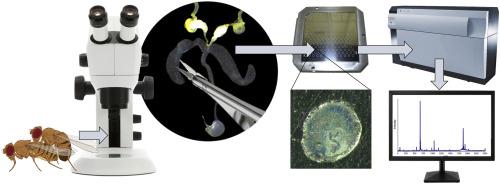Insect Biochemistry and Molecular Biology ( IF 3.2 ) Pub Date : 2020-06-24 , DOI: 10.1016/j.ibmb.2020.103414 Sebastian Sturm 1 , Adam Dowle 2 , Neil Audsley 3 , R Elwyn Isaac 1

|
In Drosophila melanogaster mating triggers profound changes in the behaviour and reproductive physiology of the female. Many of these post-mating effects are elicited by sex peptide (SP), a 36-mer pheromone made in the male accessory gland and passed to the female in the seminal fluid. The peptide comprises several structurally and functionally distinct domains, one of which consists of five 4-hydroxyprolines and induces a female immune response. The SP gene predicts an isoleucine (Ile14) sandwiched between two of the hydroxyprolines of the mature secreted peptide, but the identity of this residue was not established by peptide sequencing and amino acid analysis, presumably because of modification of the side chain. Here we have used matrix-assisted laser desorption ionisation mass spectrometry together with Fourier-transform ion cyclotron resonance mass spectrometry to show that Ile14 is modified by oxidation of the side chain - a very unusual post-translational modification. Mass spectrometric analysis of glands from different geographical populations of male D. melanogaster show that SP with six hydroxylated side chains is the most common form of the peptide, but that a sub-strain of Canton-S flies held at Leeds only has two or three hydroxylated prolines and an unmodified Ile14. The D. melanogaster genome has remarkably 17 putative hydroxylase genes that are strongly and almost exclusively expressed in the male accessory gland, suggesting that the gland is a powerhouse of protein oxidation. Strain variation in the pattern of sex peptide hydroxylation might be explained by differences in the expression of individual hydroxylase genes.
中文翻译:

果蝇性爱肽的结构:羟基化异亮氨酸的鉴定和氨基酸羟基化模式中的菌株变异。
在果蝇中,交配会触发女性行为和生殖生理的深刻变化。这些交配后效应中的许多是由性肽(SP)引发的,该性肽是在雄性副腺中制成的36聚体信息素,并在精液中传递给雌性。该肽包含几个结构和功能上不同的结构域,其中一个结构域由五个4-羟脯氨酸组成,可诱导女性免疫应答。SP基因预测异亮氨酸(Ile 14)夹在成熟分泌的肽的两个羟基脯氨酸之间,但可能由于侧链修饰而无法通过肽测序和氨基酸分析确定该残基的身份。在这里,我们将基质辅助激光解吸电离质谱与傅立叶变换离子回旋共振质谱联用,表明Ile 14被侧链氧化修饰-非常不寻常的翻译后修饰。质谱分析雄性D. melanogaster不同地理种群的腺体表明具有六个羟基化侧链的SP是肽的最常见形式,但是在利兹举行的Canton-S蝇的一个亚株只有两个或三个羟基化的脯氨酸和未修饰的Ile 14。在果蝇基因组中有反映强烈,在男性附属性腺几乎完全表达,表明腺蛋白质氧化的重地显着17假定羟化酶基因。性肽羟化模式中的菌株变异可能是由于单个羟化酶基因表达的差异所致。











































 京公网安备 11010802027423号
京公网安备 11010802027423号